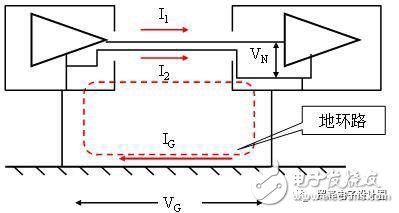Ground loops often appear without any visible signs, leaving no physical trace but only a faint signal on the oscilloscope. When an electronic device is functioning normally, this interference may suddenly emerge and then vanish. This kind of issue is commonly observed in systems where devices are connected via long cables, making it one of the most frequent types of electrical noise.
The root cause of ground loop interference lies in the presence of ground loop current. In practice, it's often noticed that when the safety ground wire of a device is removed, the interference disappears because the loop is broken. This type of phenomenon is more common at lower frequencies. However, when the interference frequency is high, the effect of grounding becomes less significant.
There are two primary causes behind the formation of ground loop interference. First, differences in ground potentials between two devices can create a ground voltage. This voltage drives a current through the loop formed by the connection between the two devices and the ground. Due to imbalances in the circuit, the currents in different wires vary, leading to a differential mode voltage that disturbs the system. Additionally, the ground line itself may carry higher currents from other power-hungry devices, and with higher impedance, this results in a voltage drop along the ground path.
Another cause is electromagnetic induction. If the interconnected devices are located within a strong electromagnetic field, this field can induce a loop current in the circuit formed by the devices and the connecting cable, causing interference.
To address ground loop issues, there are two fundamental approaches: reducing the impedance of the ground line to minimize the interference voltage, or increasing the impedance of the loop to limit the current flow. When the impedance becomes infinite, the loop is effectively broken, eliminating the interference entirely. For example, floating one end of a device or isolating a circuit board from the chassis can be simple solutions. However, these methods are not always practical due to safety and protection requirements.
A more realistic approach involves using isolation transformers, optical couplers, common-mode chokes, or balanced circuits. These techniques help break the ground loop without compromising safety.
In monitoring systems, one of the key anti-interference design principles is to connect the end device to ground at only one point, while ensuring that the front-end camera, BNC connector casing, and cable shielding are insulated from the ground (open circuit). Even with the use of anti-interference equipment, it's difficult to completely eliminate ground loop effects because the ground potential difference can change over time due to factors like increased power grid equipment or power imbalance. In extreme cases, this can even lead to equipment damage.
Here are some related images for better understanding:



Dynamic Receiver,Dynamic Receiver unit,Dynamic Receiver for cordless telephone ,150om Dynamic Receiver
Gaoyou Huasheng Electronics Co., Ltd. , https://www.yzelechs.com
